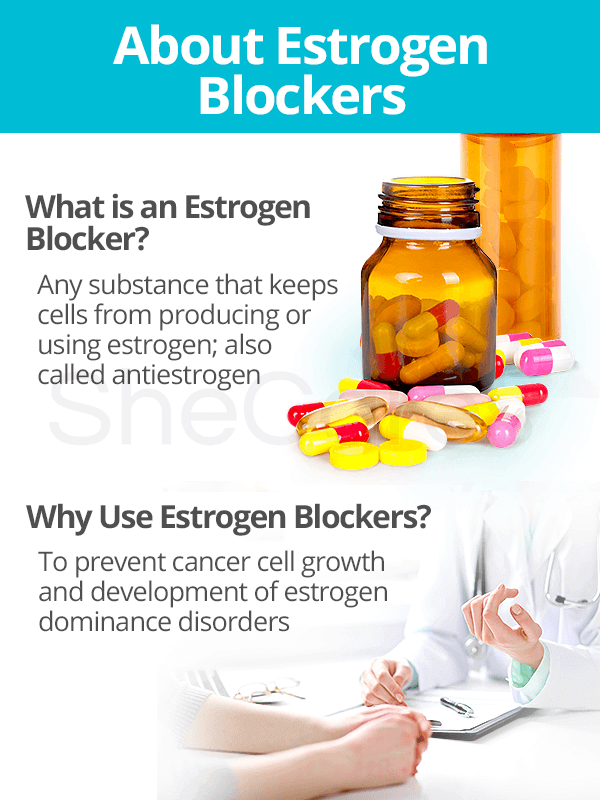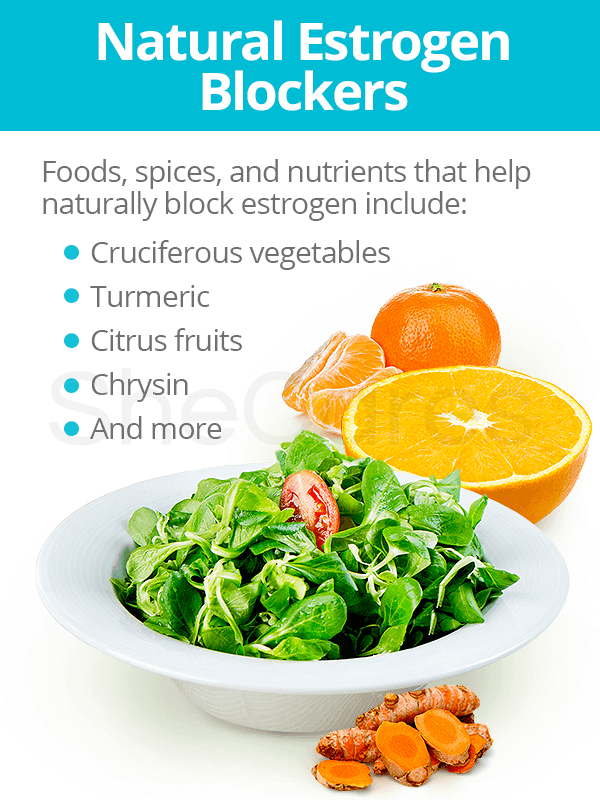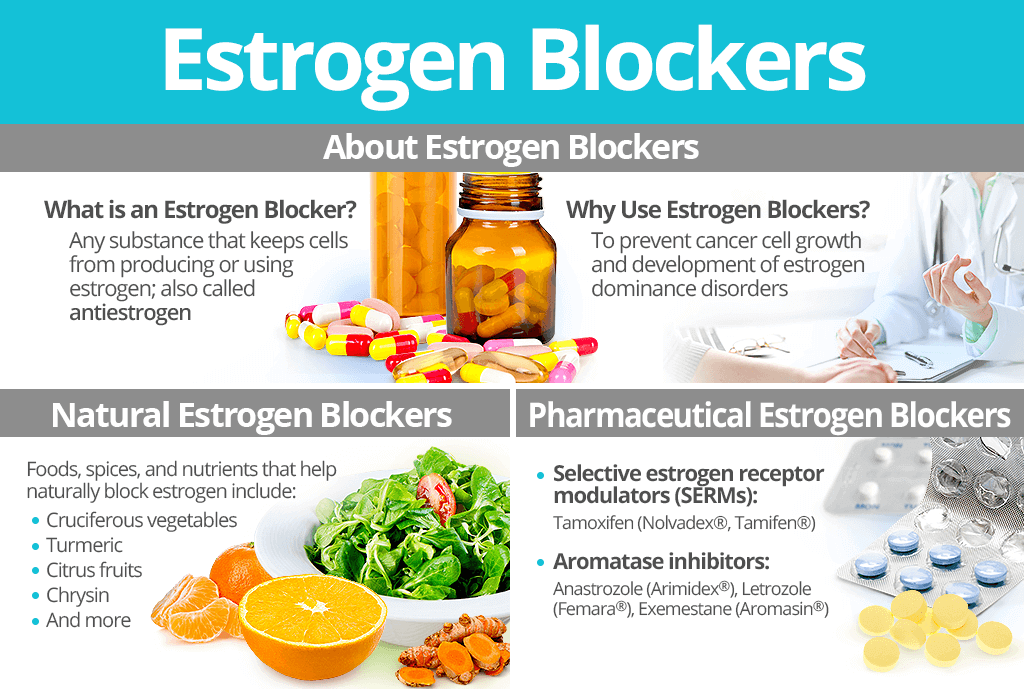For those who are estrogen dominant or looking to prevent estrogen-dominant conditions, such as breast cancer, a clear option is to use estrogen blockers.
Continue reading to learn more about natural and pharmaceutical options to block estrogen.
About Estrogen Blockers

What is an Estrogen Blocker?
An estrogen blocker is any substance that keeps cells from producing or using estrogen. It is a type of hormone antagonist and is also called an antiestrogen.
Many natural estrogen blockers include aromatase inhibitors that block the activity of the enzyme aromatase, which converts androgens into estrogen. They are primarily used in postmenopausal women since their ovaries produce too much aromatase for inhibitors to block it effectively. These inhibitors don't prevent the ovaries from making estrogen. They simply lower estrogen levels in women whose ovaries aren't making estrogen.
Why Use Estrogen Blockers?
Estrogen blockers are principally used to prevent some cancer cells from growing and are used to treat receptor-positive breast cancer. They are continually being studied for their effectiveness to lower initial breast cancer risk as well as the risk for other types of cancer, and estrogen blockers can also be used to prevent disorders from consistently high estrogen levels.
Natural Estrogen Blockers

Food and herbs have been used for centuries to help block estrogen without the clinical side effects. They also boost overall health and wellness by promoting hormonal balance and nourishing one's body accordingly.
Here is a list of some foods, spices, and nutrients found within certain foods that help naturally block estrogen:
- Cruciferous veggies. Broccoli, cauliflower, kale, and brussel sprouts contain a nutrient called diindolylmethane, or DIM, which binds to surplus estrogen to remove it from the body. Cruciferous vegetables are also rich in chlorophyll, which improves liver health for further detoxification.
- Turmeric. Research suggests turmeric reduces the effects of estrogen in some hormone-sensitive cancer cells and has strong anticarcinogenic effects in the skin, stomach, colon, breasts, and other tissues. The bright yellow, anti-inflammatory antioxidant known as curcumin is to credit.
- Citrus fruits. Citrus fruits - including oranges, lemons, grapefruits, and mandarins - are rich in vitamin C and antioxidants that help inhibit the production of estrogen levels in the body to correct hormonal imbalances.
- Chrysin. Passion flowers, honeycombs, and certain mushrooms contain the flavonoid chrysin. Chrysin has anti-inflammatory and antioxidant properties, and it is also an aromatase inhibitor that assists in blocking estrogen conversion in the body.
- Grape seed extract. Grape seed extract contains high concentrations of flavonoids that have been proven to be potent inhibitors of aromatase. For this reason, it is especially noted for use in postmenopausal women with a high risk for contracting breast cancer.
- Flaxseed. Flax is known for its lignan, α-linolenic acid, and fiber content, components that may possess phytoestrogenic, anti-inflammatory, and hormone-modulating effects, respectively. Current evidence suggests that flax - a class of lignans - may be associated with a decreased risk of breast cancer since lignans can significantly decrease the growth of carcinogenic cells. Even though this class of phytoestrogens are acclaimed to raise estrogen levels, they can also inhibit estrogenic activity in cells.
It is important to note that although natural estrogen blockers are healthier, not all of them are scientifically proven. Because each individual will react to estrogen blockers differently, it is difficult to promise efficacy.
Also, natural estrogen blockers have no effect on xenoestrogens. Xenoestrogens are ingested on a daily basis and must, therefore, be flushed out on a daily basis. This is can be done naturally with detoxifying foods, herbs, and supplements.
Pharmaceutical Estrogen Blockers

Pharmaceutical estrogen blockers are drugs made to be selective estrogen receptor modulators (SERMs) or aromatase inhibitors.
SERMs bind to estrogen receptors, preventing endogenous estrogen from binding. They block estrogenic activity and serve as estrogen antagonists in some tissues, but they also mimic estrogen effects to serve as estrogen agonists in others.
Some pharmaceutical estrogen blockers have proven to be more effective when used in conjunction with natural estrogen blockers. All of the listed have been approved for use by the FDA:
- Tamoxifen (Nolvadex®, Tamifen®, and others). Tamoxifen is an estrogen antagonist (or SERM) used in the treatment of estrogen-dependent breast cancer. The drug binds with estrogen receptors without activating growth of breast cancer cells or causing an increase in cell division. In this way, breast cancer growth is blocked.
- Anastrozole (Arimidex®, and others). This aromatase inhibitor temporarily inactivates the enzyme. Interestingly, one cohort study examined soy consumption of postmenopausal women who were on Anastrozole. Results found a decreased risk of breast cancer recurrence among those with a daily intake of more than 42 mg of isoflavones.
- Letrozole (Femara®, and others). Letrozole is another example of an aromatase inhibitor that temporarily inactivates it to block estrogen.
- Exemestane (Aromasin®, and others). Exemestane is an aromatase inhibitor that permanently inactivates the enzyme.
Contrary to natural estrogen blockers, pharmaceutical ones might have long-term side effects. The most adverse reactions are symptoms commonly present in those going through menopause, such as hot flashes, vaginal dryness, and night sweats. They can also cause muscle and join pain.
Aromatase inhibitors also tend to speed up bone loss and may raise cholesterol. For those reasons, women with osteoporosis and pre-existing coronary heart disease may wish to seek a different route of treatment.
Additionally, since Tamoxifen binds to receptors in the uterus, this proestrogenic effect can cause a rapid increase of cells in the endometrium, leading to uterine cancer. Tamoxifen may also cause strokes and blood clots in the lungs that can serious or fatal.
In sum, by keeping cells from using or producing estrogen, estrogen blockers are consumed to prevent cancer cells from growing as well as to prevent the onset of high estrogen disorders. There is a wide variety of natural and pharmaceutical estrogen blockers available. Natural options include foods, spices, and nutrients, from cruciferous vegetables and citrus fruits to turmeric and chrysin. Pharmaceutical estrogen blockers are made to be SERMs or aromatase inhibitors.
However, these aren't the only options available for achieving ultimate hormonal balance. Discover more options to lower estrogen levels.
Sources
- American Cancer Society. (2016). Aromatase Inhibitors for Lowering Breast Cancer Risk. Retrieved July 18, 2017, from https://www.cancer.org/cancer/breast-cancer/risk-and-prevention/aromatase-inhibitors-for-lowering-breast-cancer-risk.html
- Balch, P.A. (2003). Prescription for Dietary Wellness. New York: Penguin Group. Available from Google Books.
- Balunas, M.J. et al. (2008). Natural Products as Aromatase Inhibitors. Anti-Cancer Agents in Medicinal Chemistry, 8(6), 646-682. Retrieved July 12, 2017, from https://www.ncbi.nlm.nih.gov/pmc/articles/PMC3074486/
- Breastcancer.org. (2010). New Guidelines Prefer Aromatase Inhibitors Over Tamoxifen | Soy. Retrieved July 18, 2017, from http://www.breastcancer.org/research-news/20100715b | http://www.breastcancer.org/tips/nutrition/reduce_risk/foods/soy
- Chen, J. et al. (2007). Flaxseed alone or in combination with tamoxifen inhibits MCF-7 breast tumor growth in ovariectomized athymic mice with high circulating levels of estrogen. Experimental Biology and Medicine (Maywood), 232(8), 1071-1080. doi: 10.3181/0702-RM-36
- Clark, C.C. et al. (1999). Encyclopedia of Complementary Health Practice. New York: Springer Publishing Company. Available from Google Books.
- Dizon, D.S. & Duska, L.R. (2011). 100 Questions & Answers About Uterine Cancer. Massachusetts: Jones and Barlett Publishers. Available from Google Books.
- Flower, G. et al. (2014). Flax and Breast Cancer: A Systematic Review. Integrative Cancer Therapies, 13(3), 181-192. doi: 10.1177/1534735413502076
- Fritz, H. et al. (2013). Soy, Red Clover, and Isoflavones and Breast Cancer: A Systematic Review. PLOS ONE, 8(11), e81968. doi: https://doi.org/10.1371/journal.pone.0081968
- Ismail, T.A. et al. (2015). Antihypercholesterolemic Effects of Mushroom, Chrysin, Curcumin and Omega-3 in Experimental Hypercholesterolemic Rats. Journal of Food and Nutrition Research, 3(2), 77-87. doi: 10.12691/jfnr-3-2-1
- Kaur, M. et al. (2009). Anticancer and Cancer Chemopreventive Potential of Grape Seed Extract and Other Grape-Based Products. Journal of Nutrition, 139(9), 1806S-1812S. doi: 10.3945/jn.109.106864
- Kijima, I. et al. (2006). Grape Seed Extract Is an Aromatase Inhibitor and a Suppressor of Aromatase Expression. Cancer Research, 66(11). Retrieved July 18, 2017, from http://cancerres.aacrjournals.org/content/66/11/5960
- Kim, H. et al. (2006). Genistein Decreases Food Intake, Body Weight, and Fat Pad Weight and Causes Adipose Tissue Apoptosis in Ovariectomized Female Mice. Journal of Nutrition, 136(2),409-414. Retrieved July 17, 2017, from http://jn.nutrition.org/content/136/2/409.full
- Liew, L. (2003). The Natural Estrogen Diet and Recipe Book: Delicious Recipes for a Healthy Lifestyle. California: Hunter House Inc. Available from Google Books.
- Magee, P.J. & Rowland, I. (2012). Soy products in the management of breast cancer. Current Opinion in Clinical Nutrition and Metabolic Care, 15(6), 586-591. doi: 10.1097/MCO.0b013e328359156f
- Memorial Sloan Kettering Cancer Center. (n.d.). Diindolylmethane. Retrieved July 12, 2017, from https://www.mskcc.org/cancer-care/integrative-medicine/herbs/diindolylmethane
- National Cancer Institute. (2017). NCI Dictionary of Cancer Terms | Hormone Therapy for Breast Cancer. Retrieved July 18, 2017, from https://www.cancer.gov/publications/dictionaries/cancer-terms?cdrid=648588 | https://www.cancer.gov/types/breast/breast-hormone-therapy-fact-sheet
- Nolte, K. (2014). The Natural Path to Hormonal Wellness, Part 1. Publisher: Author. Available from Google Books.
- Oncology Nutrition. (2014). Soy Foods, Diet, and Tamoxifen. Retrieved July 18, 2017, from https://www.oncologynutrition.org/erfc/hot-topics/soy-foods-diet-and-tamoxifen/
- Schwab, M. (Ed.). (2008). Encyclopedia of Cancer: 2nd Edition. New York: Springer. Available from Google Books.
- Setchell, K.D.R. (2006). Guest Editorial: Assessing Risks and Benefits of Genistein and Soy. Environmental Health Perspectives, 114(6), A332-A333. Retrieved July 17, 2017, from https://www.ncbi.nlm.nih.gov/pmc/articles/PMC1480497/
